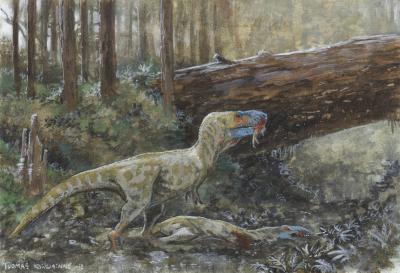
This is an artist's reconstruction of one Daspletosaurus feeding on another. A new study documents injuries inflicted in life and death to a large tyrannosaurine dinosaur. The paper shows that the skull of a genus of tyrannosaur called Daspletosaurus suffered numerous injuries during life, at least some of which were likely inflicted by another Daspletosaurus. It was also bitten after death in an apparent event of scavenging by another tyrannosaur. Thus there's evidence of combat between two large carnivores as well as one feeding on another after death.
Daspletosaurus was a large carnivore that lived in Canada and was only a little smaller than its more famous cousin Tyrannosaurus. Like other tyrannosaurs it was most likely both an active predator and scavenger. The individual in question, from Alberta Canada, was not fully grown and would be considered a 'sub-adult' in dinosaur terms (approximately equivalent to an older teenager in human terms). It would have been just under 6 m long and around 500 kg when it died.
Researchers found numerous injuries on the skull that occurred during life. Although not all of them can be attributed to bites, several are close in shape to the teeth of tyrannosaurs. In particular one bite to the back of the head had broken off part of the skull and left a circular tooth-shaped puncture though the bone. The fact that alterations to the bone's surface indicate healing means that these injuries were not fatal and the animal lived for some time after they were inflicted.
Lead author Dr David Hone from Queen Mary, University of London said "This animal clearly had a tough life suffering numerous injuries across the head including some that must have been quite nasty. The most likely candidate to have done this is another member of the same species, suggesting some serious fights between these animals during their lives".
There is no evidence that the animal died at the hands (or mouth) of another tyrannosaur. However, the preservation of the skull and other bones, and damage to the jaw bones show that after the specimen began to decay, a large tyrannosaur (possibly of the same species) bit into the animal and presumably ate at least part of it.
Combat between large carnivorous dinosaurs is already known and there is already evidence for cannibalism in various groups, including tyrannosaurs. This is however an apparently unique record with evidence of both pre- and post-mortem injuries to a single individual.
Unusually, this project was made possible via crowdfunded fundraising though the website Experiment.com. Numerous donors contributed to the project allowing the work to be carried out and as a result, publication of the paper in the Open Access journal PeerJ, means that these exciting new results are now fully open to the public, who can read them without restriction.
Source: PeerJ
 Print Article
Print Article Mail to a Friend
Mail to a Friend
